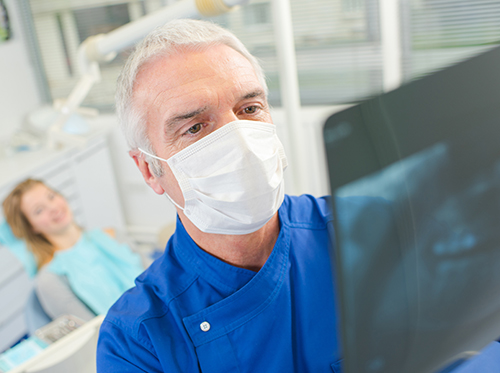February 8th, 2023

“Shouldn’t that be healthy gums,” you’re thinking? And, of course, you’re correct. Healthy gums are extremely important not only for our dental well-being, but for our overall physical health.
But that’s a subject for another blog! Today, we’re talking about healthy gum—chewing gum, that is. Because choosing the right chewing gum can actually improve your dental health.
Oral bacteria use the foods we eat, especially sugars and simple carbs, as fuel to produce acid. These acids attack our tooth enamel, gradually weakening the minerals in the tooth surface and allowing cavities to develop. Clearly, we want to reduce these acids to help prevent decay. Luckily, our bodies have a natural defense against acid attacks—saliva.
Saliva works to protect our enamel in three ways:
- It helps neutralize and wash away acids in the mouth.
- It rinses away the food particles which bacteria feed on.
- It strengthens teeth by providing the necessary minerals our enamel needs to “remineralize” after acids have weakened the tooth surface.
Studies have concluded that chewing sugarless gum for 20 minute after a meal can help prevent cavities. Why? Because chewing gum increases saliva production. You are actually reducing the effects of harmful acids, washing food particles away from your teeth, and strengthening weakened enamel with every stick! Some artificial sweeteners are even thought to inhibit the growth of the bacteria that lead to decay.
With all that in mind, it’s also healthy to know when you shouldn’t chew gum:
- When the gum contains sugar. Even with an increase in saliva production, bathing your teeth in sugar as you chew does your enamel no favors!
- When you wear braces. Gum can stick to your brackets and between your brackets and your wires. And while trying to clean gum from your appliance is no one’s idea of fun, an even more unpleasant possibility is the chance that gum might bend your wires out of shape. Sugarless gum is not quite as sticky as regular gum, but before you open that first pack, check with your orthodontist to see if you might be putting your orthodontic work at risk.
- When you have jaw problems such as TMD, TMJ or other temporomandibular concerns, or if you develop jaw pain while chewing gum.
- You should never give gum to a child too young to understand that it should not be swallowed. Beyond acting as a choking hazard, continual gum swallowing can lead to diarrhea, blockages, abdominal pain and other serious problems. Talk to your Dr. Sardzinski, Dr. Wilken, Dr. Stanley, Dr. Hanson and Dr. Heying about the right age for chewing gum.
While chewing sugarless gum has the potential to improve dental health, remember it should never take the place of regular brushing and flossing—still the best way to prevent cavities at home. Talk to Dr. Sardzinski, Dr. Wilken, Dr. Stanley, Dr. Hanson and Dr. Heying about the possible benefits of sugarless gum at your next visit to our Hiawatha, IA office, and we can make recommendations based on your individual dental history. Because whether it’s healthy gums or healthy gum, we’re here to help.
February 8th, 2023

Congratulations! You’ve made the decision to replace a missing tooth with an implant. While an implant will restore the appearance of your smile, you also know that there are many reasons that an implant will improve your health, too.
A missing tooth causes structural problems as well as cosmetic ones. Remaining teeth can shift to fill the gap, leading to wear and bite problems. Without the stimulation of biting and chewing, bone tissue under the lost tooth gradually shrinks and is resorbed. The shapes of our jaws, cheeks and lips can be affected. Replacing a lost tooth with an implant can not only restore the appearance of your smile, but maintain it.
And implant procedures have a very high rate of success. Implants are made of materials compatible with the body, and surgically placed in the jaw to act as anchors for replacement teeth. The implant will actually integrate with the bone growing around it for strong, stable, and long-lasting support. After the time it takes for the implant to integrate and the area around it to heal, a crown, designed to match your own teeth perfectly, will be securely attached to the implant post.
What can you do to help the healing process? Follow our instructions carefully. Dr. Sardzinski, Dr. Wilken, Dr. Stanley, Dr. Hanson and Dr. Heying will give you suggestions for the time immediately following the procedure as well as instructions on the importance of keeping the area clean while healing takes place. And one very important favor you can do yourself? If you smoke, this is the time to stop.
Studies have shown that smokers have a significantly increased risk of dental problems and implant failures, and there are several theories as to why.
- Smoking slows the healing process. Some studies indicate that smoking impairs blood flow in the gums, so that less oxygen and fewer nutrients are delivered to healing tissue.
- Smokers tend to be more vulnerable to gum disease.
- Smoking has been linked to a weaker immune system, so it’s harder to fight off an infection or to heal from one.
- More marginal bone loss around implants is seen in smokers than in non-smokers.
- Peri-implantitis, an inflammation of the gum tissue around the implant that can lead to bone loss and implant failure, is also more common in smokers.
Now that you have decided on a dental implant at our Hiawatha, IA office, make one more decision to ensure the success of the procedure. Talk to us about ways to quit smoking before your implant, and how to reduce the chance of smoking-related complications. We know that quitting can be difficult, but your improved smile—and your improved health—are worth it!
January 25th, 2023

X-rays have been a function of dental healthcare for a long time. That in and of itself should be good news, because it means we've had plenty of time to improve them. While there is always some risk in exposure to radiation, dental X-ray exposure has decreased significantly due to all the advances in technology. So there’s risk, but X-rays are quite safe.
Think of X-rays as you would about a car. Automobiles these days have all kinds of technology to make them as safe as possible. There's still a chance that you’ll suffer an accident. Would you stop using a car because of that risk? When it comes to dental X-rays, Dr. Sardzinski, Dr. Wilken, Dr. Stanley, Dr. Hanson and Dr. Heying and our team believe the positives clearly outweigh the negatives.
X-rays can be done digitally or with film. For film, X-rays require different exposures at different speeds to produce the image. Digital X-rays have software that automatically adjusts the exposure and produces the X-ray in a digital file. Since they substantially reduce your exposure to radiation, digital X-rays are the current standard in dental offices.
In addition to digital X-rays, lead aprons are an essential piece of X-ray safety. They help protect internal organs from X-rays by acting as a shield. They usually come with a thyroid collar as well, since that is one of the most vulnerable areas to X-rays in the body. Lead aprons can absorb up to 95% of any scatter rays that result from an X-ray. Not bad, right?
Although dental X-rays involve some radiation exposure (not all of it can be eliminated), so does everyday life. Getting too much sun, for example, can be dangerous. The truth is, we accumulate radiation in our bodies over a lifetime, so it’s worthwhile to be aware and avoid as much unnecessary exposure as possible. When it comes to your dental health, though, getting an X-ray — especially when your doctor says you need it — offers more benefits than risks.
Ask us about the type of dental X-rays we use during your next visit to our Hiawatha, IA office!
January 25th, 2023

More than one patient has come into our office and asked, “What can I do to help my teeth when wearing Invisalign?”
While everyone’s teeth and dental needs are different, there are certain things everyone can do to make wearing their Invisalign aligners a more rewarding experience. Always follow the list of instructions and tips from Dr. Sardzinski, Dr. Wilken, Dr. Stanley, Dr. Hanson and Dr. Heying, and add the following advice to your daily routine.
Always ask us about teeth whitening. Our team at Blair Ridge Dental knows how important it is for you to keep your teeth white and stain-free from the foods and drinks you consume daily. If you have attachments to your teeth, they will not whiten properly. Ask our office about teeth whitening when wearing your aligners; it might be best to wait until your treatment is complete.
Continue flossing every day. You should be flossing in any case. But it can be easy to assume that Invisalign will protect your teeth from bacteria. This is not true. Bacteria can get behind the aligners and affect the health of your teeth and gums, so keep up with your flossing schedule.
Follow the 48-hour rule when wearing your aligners. When you insert every new set of aligners, you should leave them in as much as possible during the first 48 hours. Your teeth will move more during this timeframe, and the aligners do the most good during this time.
You may experience slight discomfort while wearing your Invisalign aligners. You can take a pain reliever to help with the discomfort, but if you experience too much pain, please give us a call at our convenient Hiawatha, IA office to schedule an appointment!





